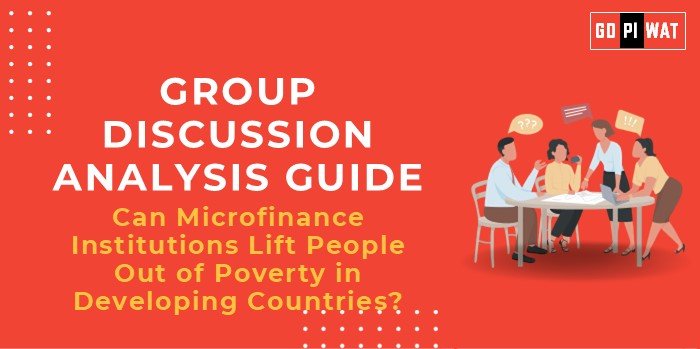📋 Group Discussion Analysis Guide
Topic: Can Microfinance Institutions Lift People Out of Poverty in Developing Countries?
🌐 Introduction to the Topic
Opening Context: Microfinance institutions (MFIs) are often seen as transformative agents in developing countries, providing financial services to those excluded from the formal banking system. Their ability to empower marginalized communities, especially women, through small loans and financial literacy, makes them pivotal in the fight against poverty.
Topic Background: Microfinance emerged as a global phenomenon with the founding of Grameen Bank by Dr. Muhammad Yunus in the 1970s. Today, MFIs serve millions worldwide, operating under the belief that access to credit can uplift communities. However, questions remain about their long-term effectiveness and scalability.
📊 Quick Facts and Key Statistics
- 🌍 Global MFI Outreach: 140+ million clients served globally; over 80% are women (World Bank, 2023).
- 📈 Impact on Poverty: A 2022 study found a 15-20% income increase for MFI beneficiaries in Bangladesh.
- 💳 Loan Repayment Rate: 95%+ repayment rates highlight borrower responsibility.
- 🌍 Regional Data: Sub-Saharan Africa accounts for 25% of MFI clients, emphasizing their prevalence in the poorest regions.
👥 Stakeholders and Their Roles
- Government Agencies: Regulate MFIs and promote financial inclusion through policies.
- Non-Governmental Organizations (NGOs): Support MFI operations with funding and training.
- Private Financial Institutions: Provide capital for MFIs and collaborate on scalable projects.
- Borrowers: Primarily low-income individuals or small entrepreneurs, often women, who utilize credit for business ventures.
📌 Achievements and Challenges
Achievements:
- 👩👩👧👦 Women Empowerment: Over 80% of borrowers are women, improving gender equity and decision-making roles in families.
- 📈 Economic Growth: Small loans fuel entrepreneurship, contributing to GDP growth in developing regions.
- 💡 Social Impact: Increased access to education and healthcare reported among MFI beneficiaries.
- 🌟 Global Success Stories: Grameen Bank in Bangladesh and SKS Microfinance in India have demonstrated scalable impact.
Challenges:
- ⚠️ Debt Overload: Some borrowers struggle to repay loans, leading to financial stress.
- 🌍 Limited Reach: Rural and conflict-prone areas remain underserved.
- 💸 Interest Rates: High-interest rates often negate the benefits for borrowers.
- 🌐 Global Comparisons: While Bangladesh has achieved substantial success, replication in Africa and Latin America has been inconsistent.
🗣️ Structured Arguments for Discussion
- Supporting Stance: “Microfinance has lifted millions out of poverty by empowering small entrepreneurs and providing access to credit.”
- Opposing Stance: “High-interest rates and limited scalability often exacerbate financial vulnerabilities instead of alleviating poverty.”
- Balanced Perspective: “While microfinance has demonstrated significant potential, it requires structural improvements for broader, sustainable impact.”
💡 Effective Discussion Approaches
- Opening Approaches:
- 📜 Historical Perspective: Reference the success of Grameen Bank and its global influence.
- 📊 Statistical Angle: Highlight the 140+ million clients served globally as evidence of MFI impact.
- Counter-Argument Handling:
- Point out high-interest rates and propose solutions like subsidies or interest caps.
- Acknowledge borrower defaults but suggest better financial literacy programs to mitigate this issue.
🔍 Strategic Analysis of Strengths and Weaknesses
- Strengths: Empowerment of women, high repayment rates, GDP contributions.
- Weaknesses: High-interest rates, over-indebtedness, limited rural reach.
- Opportunities: Digital microfinance, partnerships with NGOs, financial education.
- Threats: Regulatory hurdles, economic downturns, predatory lending practices.
🏫 Connecting with B-School Applications
- Real-World Applications: Microfinance ties to B-school themes in social entrepreneurship, rural development, and financial inclusion.
- Sample Interview Questions:
- How can MFIs integrate digital tools for better outreach?
- Are MFIs more effective than government welfare programs?
- Insights for B-School Students:
- Research areas: Digital microfinance innovations.
- Internship ideas: Collaborations with leading MFIs or NGOs in underserved regions.


